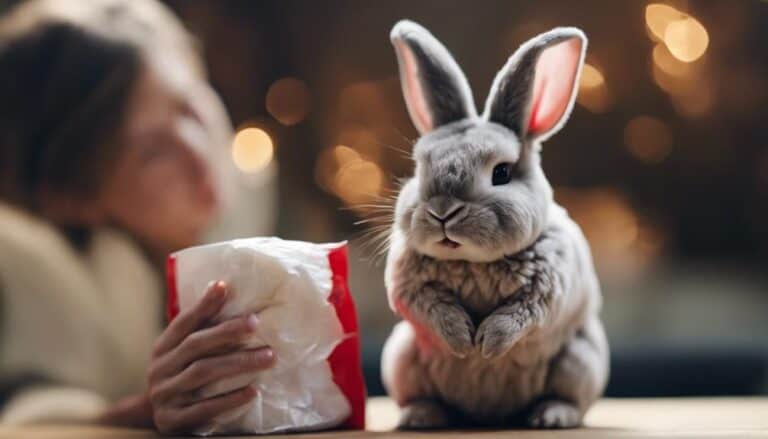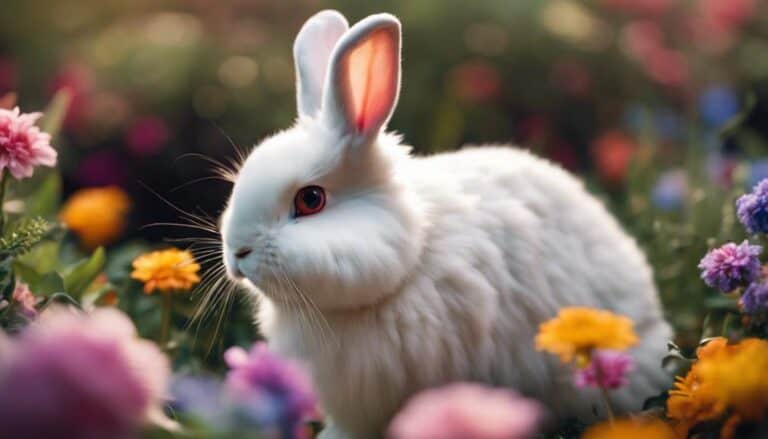When you're trying to bond your bunnies together, keep an eye on how they're acting – like where their ears are pointing and if they're thumping. It's a good idea to pick a spot that's neutral for their first meetings to avoid any arguments over territory.
Start off with short bonding sessions and slowly make them longer, paying attention to when they're getting along well. You can help encourage bonding by giving them treats and making sure they're in a calm environment where they feel safe to groom each other.
If one bunny is being too pushy or dominant, give them space and don't hesitate to get advice from an expert if needed. It's important to give them breaks to ease any tensions and keep a close watch on them. Make sure they have hiding spots to feel secure in their environment.
By following these tips, you can help your bunnies form a strong bond and enjoy a happy, peaceful relationship.
Contents
Key Takeaways
When introducing your pets to each other, it's best to pick a neutral location where neither one feels territorial. Start with short bonding sessions and gradually increase the time they spend together. You can encourage positive interactions by rewarding them with treats when they groom each other.
If you notice any signs of dominance, like growling or aggressive behavior, address it promptly to avoid escalating tension between them. It's important to give them breaks during their interactions to prevent any potential aggression and allow them to relax. Remember, patience and positive reinforcement are key to helping your pets get along.
Understanding Bunny Body Language
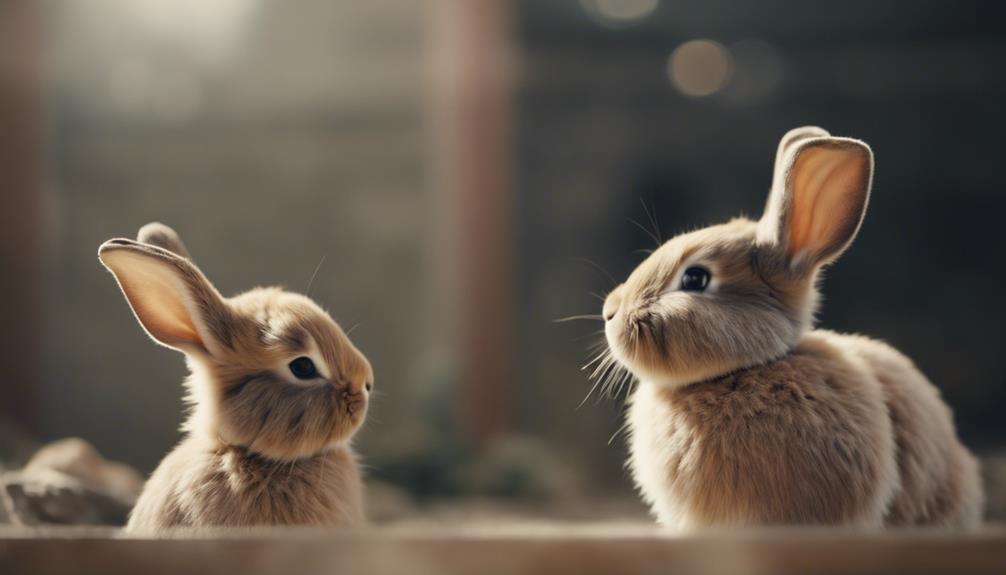
Understanding bunny body language is really important if you want to connect well with your rabbits. They've their own way of talking to us through their ears, body, and tail movements. For example, when a bunny's ears are pulled back, it could mean they're scared or feeling a bit aggressive. But if their ears are perked forward, it usually means they're curious or happy.
When a bunny's body is all relaxed and their tail is up, that's a good sign! It means they're feeling happy and comfy in their surroundings. On the flip side, if they start thumping their hind legs, it could be a signal that they're stressed out or giving a warning to other bunnies around.
Establishing Neutral Territory
When you're bringing two rabbits together for the first time, it's important to pick a spot that's new to both of them. This helps avoid any territorial issues and sets the stage for them to start getting along. Keep an eye on them while they interact in this neutral territory to make sure things stay positive.
Start off in a quiet area without any distractions so the rabbits can focus on each other. As they get more comfortable, you can slowly introduce toys and hiding spots to the neutral space. If you see them sniffing around and exploring, it's a good sign that they're accepting the new area.
Gradual Increase in Bonding Time
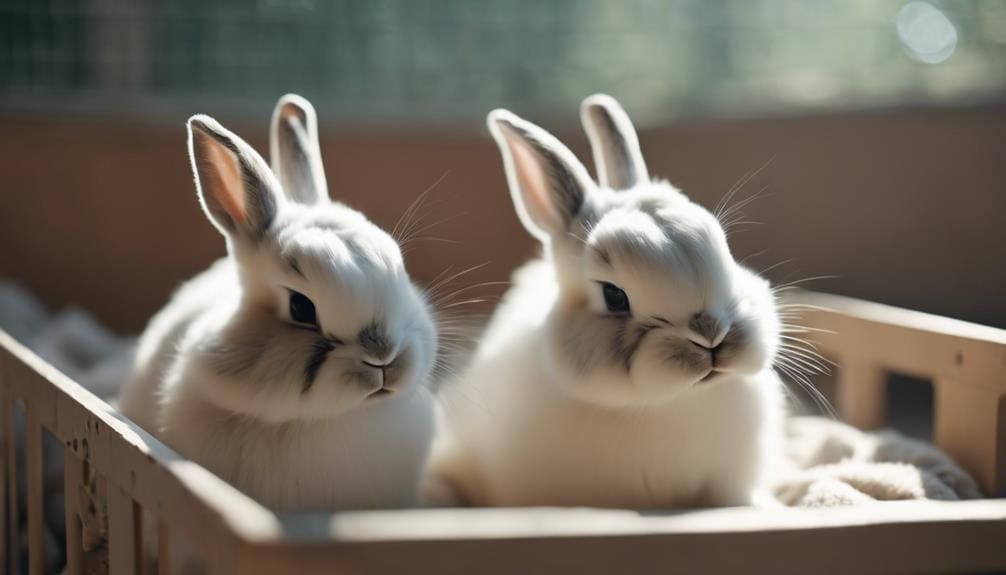
When you're helping your two rabbits bond, it's important to take it slow and steady. Start by having short bonding sessions each day, and gradually increase the time they spend together. This way, your rabbits can get used to each other without feeling overwhelmed. Keep an eye on how they behave during these sessions to make sure they're comfortable with each other.
Begin with short, supervised sessions to let your rabbits get acquainted with each other. Watch closely to see how they interact and if they seem at ease. If they show positive behaviors, like grooming or nuzzling, you can slowly extend the bonding time. This helps build trust and familiarity between your rabbits.
As your rabbits start to feel more comfortable with each other, you can gradually increase the length of their bonding sessions. Move from shorter periods to longer ones as they become more relaxed and friendly with each other. This way, they can build a strong bond over time.
Encouraging Grooming Behaviors
When you're trying to help your rabbits bond and groom each other, giving them treats like mashed banana or unsweetened applesauce can really boost their interaction and social connection. Grooming is a crucial sign that your rabbits are getting closer and forming a strong bond. By placing treats on their foreheads, you can encourage them to groom each other while enjoying a tasty treat. This simple trick can kickstart grooming behaviors and strengthen their bond.
It's important to create a calm and comfortable environment during bonding sessions to promote grooming behaviors. When rabbits feel safe and relaxed, they're more likely to groom each other. This grooming not only enhances their bond but also builds trust and companionship between them. Keep an eye on their body language and signals to ensure that the grooming interactions are positive and beneficial for both rabbits. Encouraging grooming behaviors is a wonderful way to nurture the relationship between your rabbits and foster a harmonious bond.
Addressing Dominance Issues
When you're helping your rabbits bond, it's important to understand and deal with dominance issues to ensure they get along well. Dominance behaviors like chasing, mounting, and nipping are normal as they figure out who's in charge. Here are some tips to help you handle dominance issues smoothly:
First off, keep an eye on your rabbits' behaviors to spot any dominance displays and see how they interact with each other. It's like getting a peek into their rabbit world!
Make sure your rabbits have plenty of space to establish their pecking order without feeling cramped or threatened. Space is key for them to sort out their hierarchy peacefully.
If things start to get too intense and the dominance behaviors lead to serious fights, it's okay to step in and separate them. But whenever possible, let them work out their hierarchy on their own—it's their way of figuring things out.
And if you're finding it tough to handle the dominance issues or if the conflicts keep happening, don't hesitate to reach out to a rabbit-savvy vet or an animal behaviorist for some expert advice. They can give you some tips tailored to your rabbits' specific situation.
Allowing for Breaks When Needed
When you're bonding your rabbits, it's important to take breaks strategically to help them relax and have successful interactions. These breaks are key in reducing tension and preventing any aggressive behavior between your bunnies. Giving them some time apart allows them to calm down, reset, and process their emotions before getting back to bonding. It's crucial to keep an eye on your rabbits during these breaks to ensure they're ready and in a good place to continue their interactions positively.
These little breaks in the bonding process give your rabbits a chance to think about how things are going, which can lead to better bonding sessions overall. Not only do breaks help your bunnies, but they also prevent burnout for everyone involved in the bonding process. By taking breaks when needed, you're creating a safe and supportive environment that encourages a happy relationship between your bunnies. Remember, keeping an eye on their behavior and well-being during breaks is key to a successful bonding journey.
Creating a Safe Interaction Environment
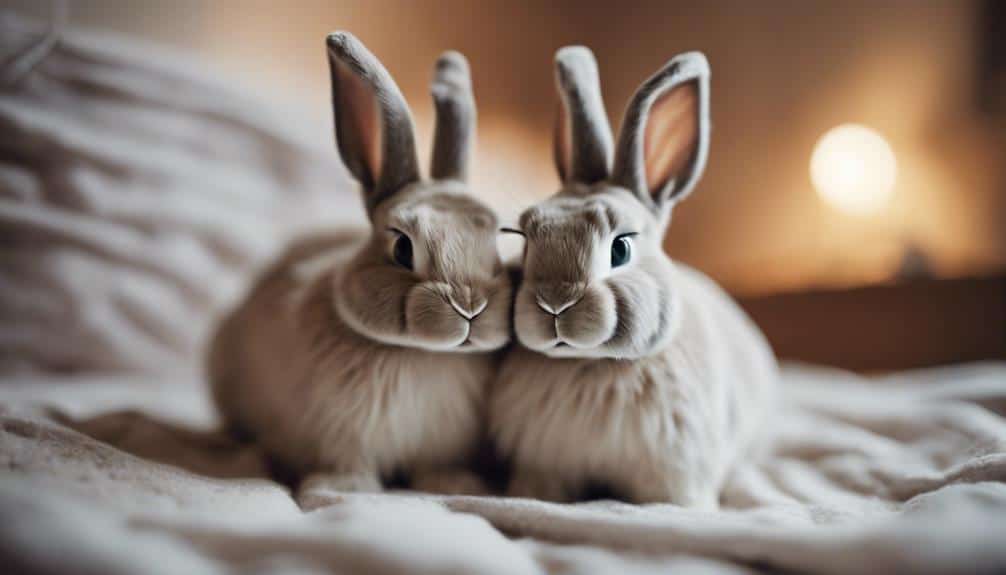
If you want your bunnies to get along, make sure they meet in a safe place first, like a hallway or a separate room.
Keep an eye on them while they interact, and give them lots of places to hide if they feel scared.
These steps can help your bunnies bond well together.
Secure Bunny Space
When setting up a safe area for your bonded bunnies to interact, the first step is to make sure the space is secure and free of any potential dangers. This means removing things like electrical cords and toxic plants that could harm your rabbits.
You can also use barriers like baby gates to create a designated safe area for your bunnies to bond in. This helps prevent them from wandering off or getting into any trouble.
It's important to eliminate any hiding spots that could lead to your rabbits getting stuck or feeling cornered during their interaction. This will help them feel more comfortable and secure in the bonding area.
Make sure to provide ample space for your bunnies to move around freely without feeling cramped or trapped. Giving them enough room to explore and interact will help create a positive bonding experience for them.
Monitoring Interactions Closely
When you're watching your bonded bunnies together, make sure to pay close attention to how they interact. This is really important for their safety and comfort. By keeping a close eye on their behavior, you can spot any signs of aggression, fear, or stress in either rabbit. If you notice any aggressive actions starting to happen, be ready to step in right away. It's key to set up a safe environment with places to hide and easy ways for the bunnies to go to separate areas if they need to.
Pay attention to their body language and sounds to understand how they're communicating during the bonding process. Being vigilant and focused will help make sure the bonding goes smoothly and successfully for your bunnies. Remember, their well-being is what matters most.
Provide Hiding Spots
When bonding your bunnies, it's important to create a safe and secure environment for them to interact. This means giving them access to various hiding spots like boxes, tunnels, and cozy corners. Why is this so important? Let's break it down:
First off, having multiple hiding spots allows each bunny to have their own personal space. This helps to reduce the chances of conflicts between them.
Secondly, hiding spots provide a sense of security for your bunnies, which can help lower their stress levels during interactions.
Plus, offering hiding spots encourages natural behavior in rabbits. They instinctively seek out hiding spots for safety, so having them around promotes their natural instincts.
Lastly, make sure the hiding spots are easy to get to with multiple entry and exit points. This way, your bunnies won't feel trapped and can move around freely.
Frequently Asked Questions
What Is 24 7 Rabbit Bonding?
Bonding rabbits 24/7 is basically playing matchmaker for bunnies. You're the referee, therapist, and cheerleader all rolled into one. You gotta keep a close eye on their every hop, squabble, and cuddle to make sure they become best fluffy friends.
How Do You Bond Rabbits Successfully?
When you're trying to bond rabbits together, it's important to use bonding techniques like keeping them in side-by-side housing and introducing them in neutral territory. Make sure the bunnies get along well, build trust between them, and keep track of how they're getting along. Positive interactions help create a strong bond between them, so aim to keep all their sessions positive for the best results.
What Are Good Signs When Bonding Rabbits?
When you're bonding rabbits, keep an eye out for signs that they're comfortable and connected. Things like grooming each other, sharing food, and playing together are all good signs. These behaviors show that your bunnies have a strong and trusting bond.
What Are Positive Behaviors When Bonding Rabbits?
When you're bonding rabbits, keep an eye out for signs like social grooming, playful hopping, snuggle sessions, and sharing treats. These behaviors mean that your bunnies trust each other, feel comfortable, and are becoming friends. It shows that they're forming a strong and loving bond.
Conclusion
Hey there! Great job on successfully bonding your bunnies!
Building a strong bond between your furry friends is like a delicate dance – it takes time, patience, and understanding.
By following these tips and paying attention to their body language, you're on the right track to creating a harmonious relationship between your bunnies.
Keep it up and enjoy watching your bunnies hop happily together in their newfound friendship!


